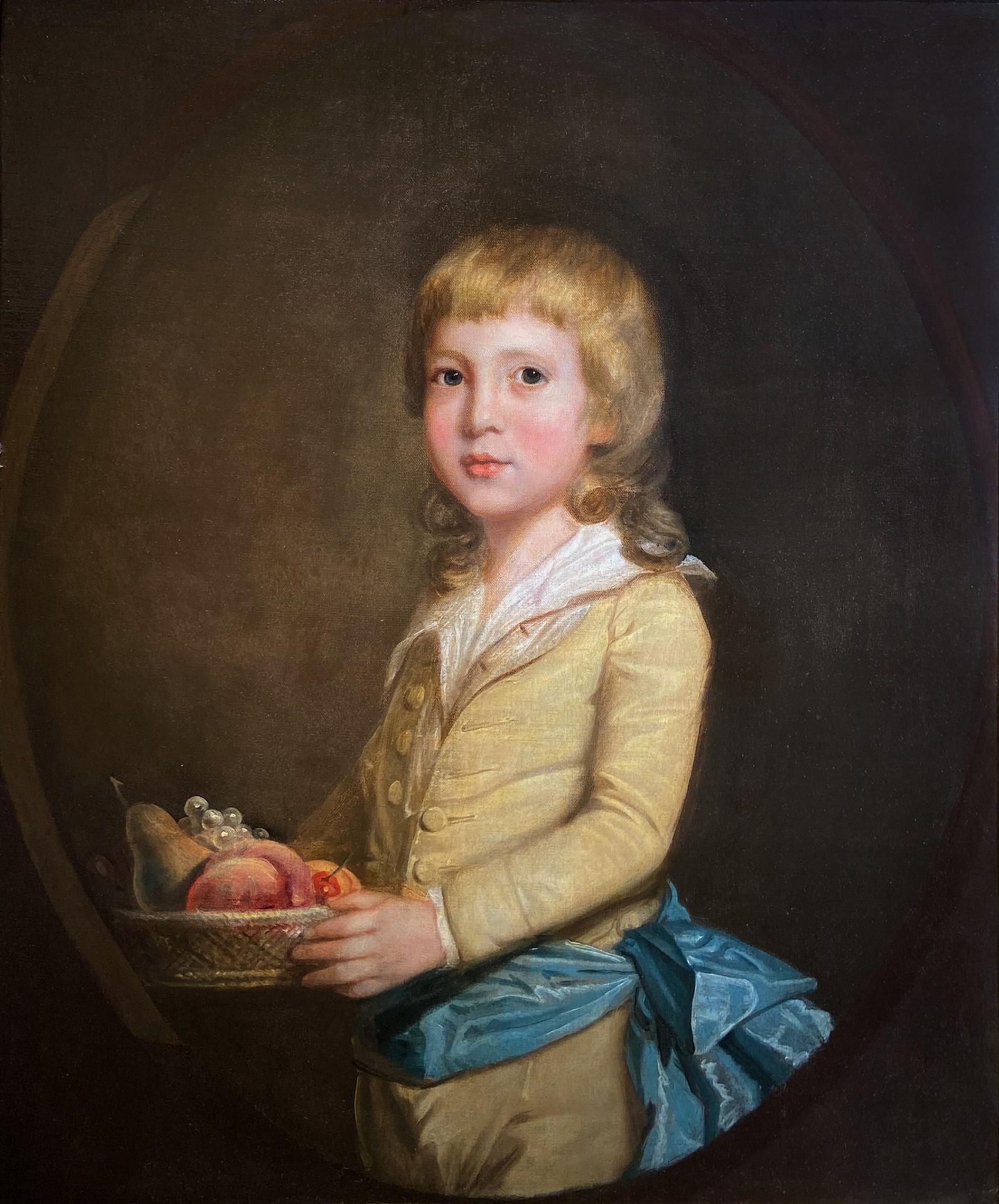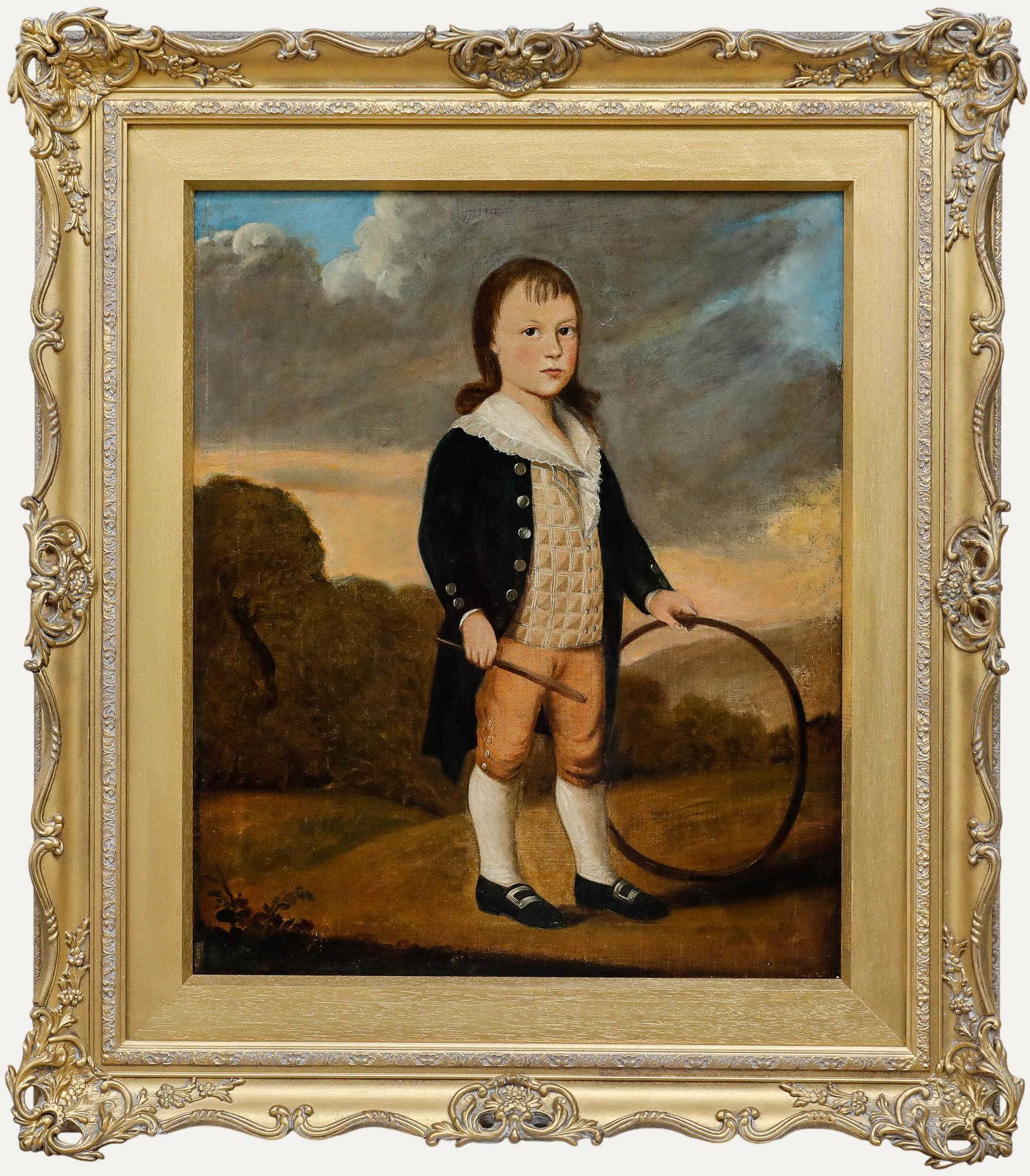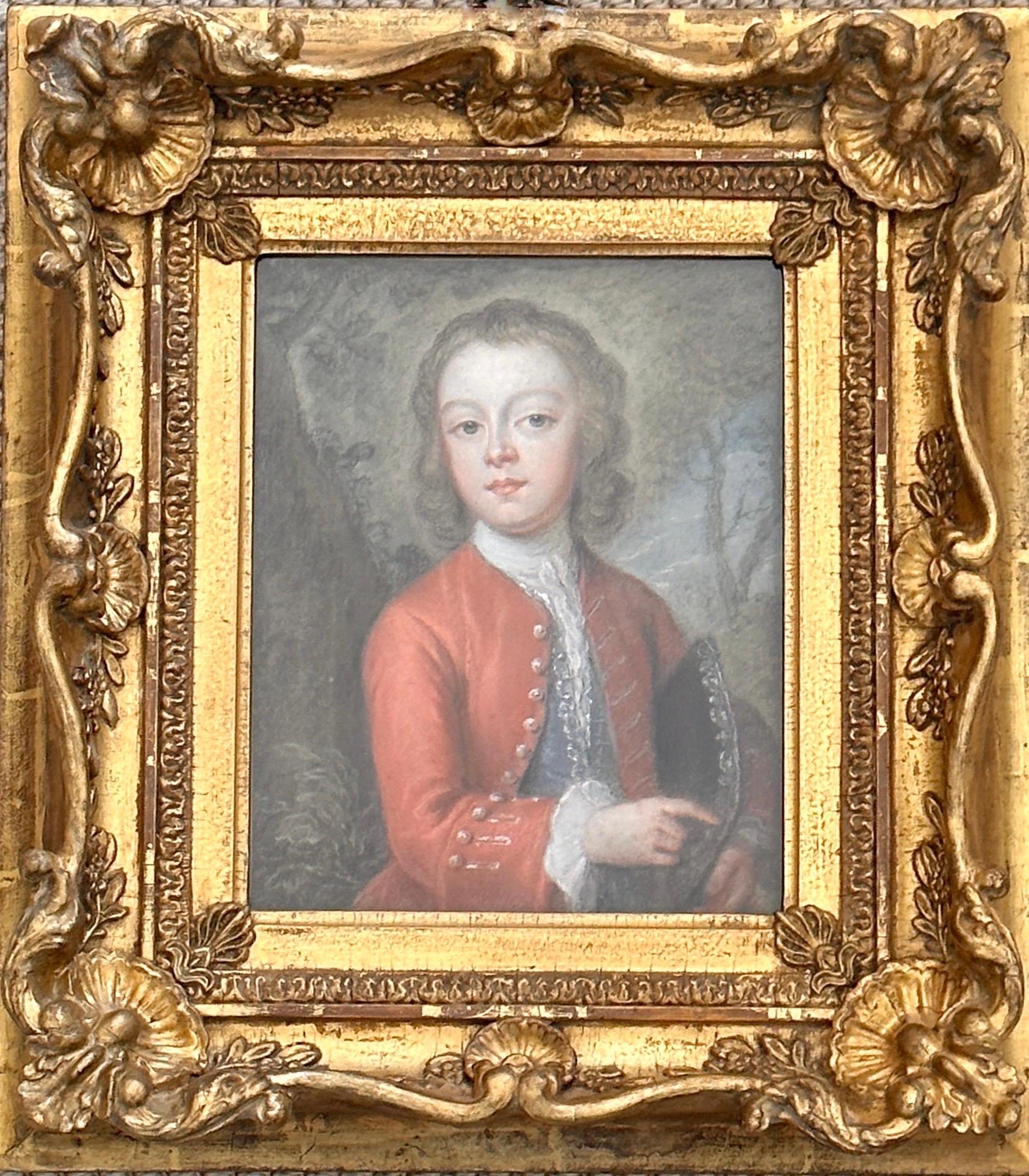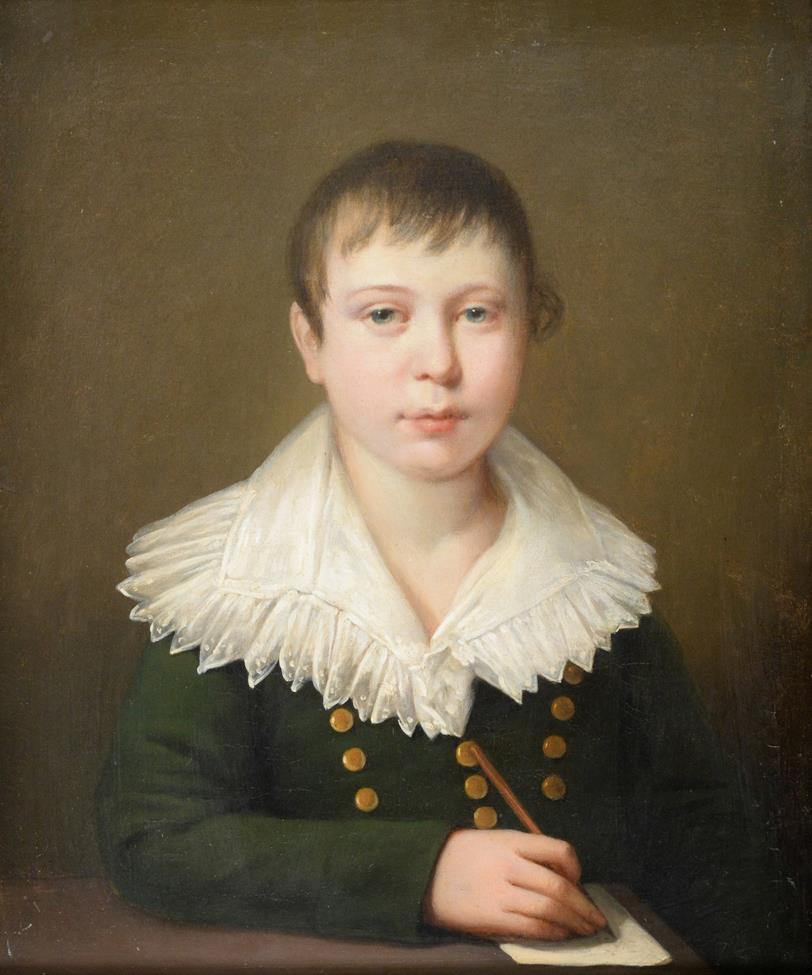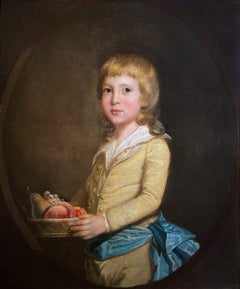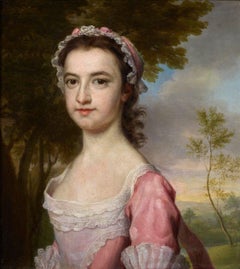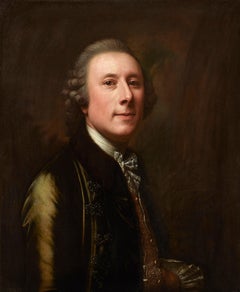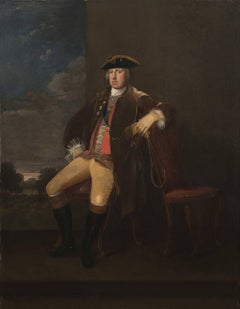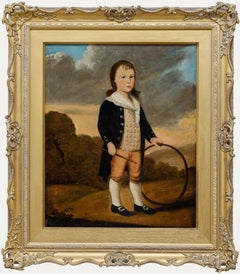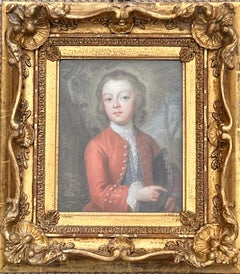Items Similar to Portrait of a Young Boy Carrying a Fruit Basket, 18th Century Oil on Canvas
Want more images or videos?
Request additional images or videos from the seller
1 of 6
Portrait of a Young Boy Carrying a Fruit Basket, 18th Century Oil on Canvas
$13,502.87
£9,800
€11,597.41
CA$18,603.70
A$20,727.15
CHF 10,820.55
MX$251,655.22
NOK 136,007.29
SEK 128,559.93
DKK 86,573.29
About the Item
Oil on canvas
Image size: 30 x 25 inches (76 x 63.5 cm)
Hand carved gilt frame
This is a charming 18th century portrait of a young boy, sporting a golden child's two-piece with a floppy white collar. The boy stands before a dark blank background holding a small basket that is full of different fruits. The fresh faced young sitter is pictured half length within an oval cartouche. There is lovely detail and brushwork in his facial features and vibrant colouring. He wears the traditional costume of aristocratic young gentlemen of the period, including a dramatic ice blue cloak that is wrapped around his hips.
Sir William Beechey
Sir William Beechey RA (12 December 1753 – 28 January 1839) was a leading English portraitist during the golden age of British painting.
Beechey was born at Burford, Oxfordshire, on 12 December 1753, the son of William Beechey, a solicitor, and his wife Hannah Read. Both parents died when he was still quite young, and he and his siblings were brought up by his uncle Samuel, a solicitor who lived in nearby Chipping Norton. The uncle was determined that the young Beechey should likewise follow a career in the law, and at an appropriate age he was entered as a clerk with a conveyancer near Stow-on-the-Wold. But as The Monthly Mirror later recorded in July 1798, he was "Early foredoomed his [uncle's] soul to cross/ And paint a picture where he should engross."
Beechey was admitted to the Royal Academy Schools in 1772, where he is thought to have studied under Johan Zoffany. He first exhibited at the Academy in 1776. His earliest surviving portraits are small-scale full-length and conversation pieces which are reminiscent of Zoffany. In 1782, he moved to Norwich, where he gained several commissions, including a portrait of Sir John Wodehouse and a series of civic portraits for St. Andrew's Hall, Norwich. By 1787, he had returned to London, and in 1789, he exhibited a celebrated portrait of John Douglas, Bishop of Carlisle (now in Lambeth Palace). Beechey’s career during this period is marked by a succession of adept and restrained portraits in the tradition of Sir Joshua Reynolds.
Beechey’s style perfectly suited the conventional taste of the royal family, and in 1793, he was commissioned to paint a full-length portrait of Queen Charlotte and subsequently named as her official portrait painter. That same year, he was elected as an associate member of the Royal Academy. Following his royal appointment, the number of royal commissions he undertook increased markedly, and in 1797 he exhibited six royal portraits. In 1798, he was elected a full member of the Royal Academy and painted George III and the Prince of Wales Reviewing Troops for that year’s academy’s exhibition. This enormous composition depicts King George III, the Prince of Wales and staff officers on horseback at an imagined cavalry review in Hyde Park. The king was reported to be delighted with the painting and rewarded Beechey with a knighthood Joseph Farington's Diaries give many accounts of Beechey's relations with the royal family during this period, including his temporary fall from favour in 1804, which Farington attributes to the vagaries of George III’s mental condition.
Beechey's portraits of the turn of the century are considered to be his most colourful and lively. They are closer to the flamboyant and free techniques employed by his younger rivals, John Hoppner and Sir Thomas Lawrence. Although capable of impetuousness and irascibility, Beechey was known for his generosity to students. In particular, he took a close interest in the career of the young John Constable.
Royal patronage resumed in around 1813, when Beechey was appointed portrait painter to Prince William Frederick, Duke of Gloucester, and culminated with his appointment in 1830 as principal portrait painter to King William IV. In 1836, Beechey retired to Hampstead and on 9-11 June that year, the contents of his studio along with his collection were sold at Christie’s.
- Attributed to:Sir William Beechey (1753 - 1839, British)
- Dimensions:Height: 30 in (76.2 cm)Width: 23 in (58.42 cm)
- More Editions & Sizes:1 of 1Price: $13,503
- Medium:
- Movement & Style:
- Period:
- Condition:
- Gallery Location:London, GB
- Reference Number:1stDibs: LU52414261892
About the Seller
5.0
Vetted Professional Seller
Every seller passes strict standards for authenticity and reliability
Established in 2007
1stDibs seller since 2014
82 sales on 1stDibs
Typical response time: 3 hours
- ShippingRetrieving quote...Shipping from: London, United Kingdom
- Return Policy
Authenticity Guarantee
In the unlikely event there’s an issue with an item’s authenticity, contact us within 1 year for a full refund. DetailsMoney-Back Guarantee
If your item is not as described, is damaged in transit, or does not arrive, contact us within 7 days for a full refund. Details24-Hour Cancellation
You have a 24-hour grace period in which to reconsider your purchase, with no questions asked.Vetted Professional Sellers
Our world-class sellers must adhere to strict standards for service and quality, maintaining the integrity of our listings.Price-Match Guarantee
If you find that a seller listed the same item for a lower price elsewhere, we’ll match it.Trusted Global Delivery
Our best-in-class carrier network provides specialized shipping options worldwide, including custom delivery.More From This Seller
View AllPortrait of a Young Boy Carrying a Fruit Basket, 18th Century Oil on Canvas
By Thomas Beach
Located in London, GB
Oil on canvas
Image size: 30 x 25 inches (76 x 63.5 cm)
Contemporary hand-carved frame
This is a charming 18th century portrait of a young boy, sporting a golden child's two-piece w...
Category
18th Century English School Portrait Paintings
Materials
Canvas, Oil
Portrait of a Girl, 18th Century Oil Old Master
By George Knapton
Located in London, GB
George Knapton
1698-1778
Portrait of a Girl
Oil on canvas
Image size: 20 x 18 inches
Original giltwood frame
This beautiful half length portrait of a young woman, turned to left, gazing at the spectator, wearing a pink, white lace-embroidered, dress, in her hair a pink bonnet trimmed with lace to match her dress.
The depiction of a young girl epitomises child portraiture of the late eighteenth century, in which painters such as William Beechey, Joshua Reynolds, Thomas Gainsborough had begun to discover and express the true character of children, in contrast to the stiff, miniature-adults of previous generations.
The Artist
Knapton was born in Lymington, one of four sons of James Knapton. He was apprenticed to Jonathan Richardson from 1715 to 1722, and in 1720 was a founding subscriber to the academy of St. Martin's Lane established by Louis Chéron...
Category
18th Century Old Masters Portrait Paintings
Materials
Canvas, Oil
Portrait of a Gentleman, 18th Century Oil Painting
By Anton von Maron
Located in London, GB
Oil on canvas
Image size: 20 x 24 inches (51 x 61 cm)
Period gilt frame
This is a half-length portrait of a gentleman wearing a emerald coat and intricately designed waistcoat, dat...
Category
1760s Portrait Paintings
Materials
Canvas, Oil
Portrait of a King's Messenger, 18th Century English Artist, Original Frame
By Charles Philips
Located in London, GB
Charles Philips
1703 - 1747
Portrait of a King's Messenger
Oil on canvas
Image size: 35 ¾ x 28 inches
Original gilt frame
King's Messenger
The job of a King's Messenger was that of a diplomatic courier, hand-carrying important and secret documents around the world. Some say that the history of the sovereigns' messengers goes back to 1199, but the first known messenger was John Norman, who in 1485 earned 4d (1½ pence) per day for carrying the state papers of Richard III.
The silver greyhound on the messenger's badge dates back to Charles II. In 1660, during his exile at Breda, Netherlands, Charles II issued a declaration of amnesty to all those who had opposed him and his father. He used messengers to make his intentions known. In answer to the messenger's question "How will they know me?", Charles reached forward to a silver bowl on the table in front of him. This bowl, with four decorative greyhounds standing proud above the rim, was well known to all courtiers. Charles broke off a greyhound and gave it to the messenger as a guarantee that the message came from him. From that date, the King's Messenger always wore a silver greyhound around his neck.
Later, dating from George II or III, a badge with the Royal Arms in enamel, with the greyhound suspended beneath, was worn. A George III example of the King's Messenger Badge, pre 1800, sold for over £30,000 pounds some years ago.
The silver greyhounds were minted for each new reign, except the brief one of King Edward VIII. The sovereign's messengers were originally controlled by the Lord Chamberlain, being Messengers of the Great Chamber. When the Foreign Office was created in 1782, the messengers remained common to the three Secretaries of State.
Charles Philips was an English artist known for painting a number of portraits and conversation pieces for noble and Royal patrons in the mid-eighteenth century.
Philips was baptised in the combined parish of St Mildred, Poultry with St Mary...
Category
18th Century Portrait Paintings
Materials
Canvas, Oil
Portrait of Ralph William Grey
By Bartholomew Dandridge
Located in London, GB
Provenance
By descent through the sitter's family to
The Collection of R. W. Vivian-Neal of Poundisford Park, Somerset, from whom acquired by
With Lane Fine Art, UK, where purchased by the present owners in 1996
Literature
'Poundisford Park, Somerset' in Country Life, 22 December 1934, ill.
A.W. and C.M. Vivian-Neal, Poundisford Park, Somerset: A catalogue of pictures and furniture, Taunton 1939, cat. nos. 11 and 13
This is a three-quarter-length portrait of Ralph William Grey in a mole-coloured velvet coat and a long waistcoat of green satin, heavily embroidered in gold. Under his left right hand is a black chapeau bras. He has white doe-skin gauntlet gloves.
Son of William and Ann Grey of Backworth: born 19 December 1707. He married Mary the daughter of William Rawstorne of Newall in 1741 and died 5 November 1786. He was educated at Eaton and Trinity College, Oxford.
Within a year of his birth Mrs Grey died and, according to the Country Life article 'From that time forward all Mr Grey's faculties were concentrated on the well-being of his son. The possession of an heir gave zest to his efforts to build up the family fortune: he was successful in most of his ventures. Years later his interest in life was centred in the home of his daughter-in-law and grandchildren'.
Grey's right hand is depicted in the present portrait resting on Locke's Essays and the Country Life article also records that there are constant references to John Locke...
Category
Mid-18th Century English School Portrait Paintings
Materials
Oil
Portrait of a Man with a Rifle
Located in London, GB
Oil on layered paper
Image size: 10 1/2 x 8 1/4 inches (26.5 x 21 cm)
Contemporary swept frame
This is an eighteenth century portrait of a...
Category
Late 18th Century Naturalistic Figurative Paintings
Materials
Oil, Laid Paper
You May Also Like
English School 18th Century Oil - Boy with A Hoop
Located in Corsham, GB
This 18th century portrait depicts a young child in formal attire standing in a pastoral landscape, holding a hoop toy. The composition juxtaposes the subject's rigid pose and ornate...
Category
Early 18th Century Portrait Paintings
Materials
Oil
Portrait Young Boy Lombard School 17th Century Paint Oil on canvas Old master
Located in Riva del Garda, IT
Lombard School, 17th century
Portrait of a Young Boy
oil on canvas
109 x 78 cm - 127 x 97 cm with frame
The protagonist of the offered canvas is a chubby little boy, aged approxima...
Category
17th Century Old Masters Paintings
Materials
Oil
$9,263 Sale Price
20% Off
Portrait of a Young Boy - British art 1780 Old Master male portrait oil painting
By Joseph Wright of Derby
Located in Hagley, England
This lovely Old Master portrait oil painting is attributed to the circle of Joseph Wright of Derby. Painted circa 1780 the painting is of a boy in a tunic and wide collar. A really c...
Category
18th Century Old Masters Portrait Paintings
Materials
Oil
18th century pastel portrait of a young boy in a wooded landscape
By Arthur Pond
Located in Bath, Somerset
This little jewel of a pastel of a young boy in his smart red jacket and silver trimmed waistcoat is by an artist working in the circle of Arthur Pond and ...
Category
18th Century English School Portrait Paintings
Materials
Pastel
$7,715 Sale Price
20% Off
Fine 1800's Portrait of Young Aristocratic Boy with Letter & Pen Oil on Canvas
Located in Cirencester, Gloucestershire
Portrait of a Young Aristocrat
French School, circa 1800's
circle of Louis Leopold Boilly (1761-1845)
oil painting on canvas, framed
canvas: 16 x 13.5 inches
frame: 21 x 18 inches
p...
Category
Early 19th Century Rococo Portrait Paintings
Materials
Canvas, Oil
$3,857 Sale Price
30% Off
Portrait of a Girl with Basket of Flowers -British 18thC Old Master oil painting
Located in Hagley, England
This charming 18th century Old Master cartouche portrait oil painting is attributed to the circle of Philip Mercier. Painted circa 1740 the composition is a three quarter length portrait of a young girl holding a wicker basket of flowers. She is clothed in a white dress and beautiful blue silk shawl and is situated in a landscape. A very lovely British Old Master portrait oil painting.
Provenance. Christies.
Condition. Oil on canvas, 30 inches by 25 inches and in good condition.
Frame. Housed in an ornate gilt carved 18th century frame, 38 inches by 33 inches and in good condition.
Philippe Mercier (also known as Philip Mercier; 1689-1760) was a French painter and etcher, who lived principally and was active in England. He was born in Berlin of French extraction, the son of a Huguenot tapestry-worker. He studied painting at the Akademie der Wissenschaften of Berlin and later under Antoine Pesne, who had arrived in Berlin in 1710. Later, he travelled in Italy and France before arriving in London—"recommended by the Court at Hannover"—probably in 1716. He married in London in 1719 and lived in Leicester Fields. He was appointed principal painter and librarian to the Prince and Princess of Wales at their independent establishment in Leicester Fields, and while he was in favour he painted various portraits of...
Category
18th Century Old Masters Portrait Paintings
Materials
Oil
More Ways To Browse
18th Century English Painting
18th Century English Portrait
Antique Oval Portrait
Antique Fruit Basket
18th Century Costume
Antique Fruit Stand
Boy George
Boyer Georges
George Read Art
Andrew King
Fruit Frame Mirror
John Douglas
King William Iii
Fruit Carved Mirror
18th Century Carved Oval Frame
Boy With Basket
Queen Charlotte
Frederick Childs
